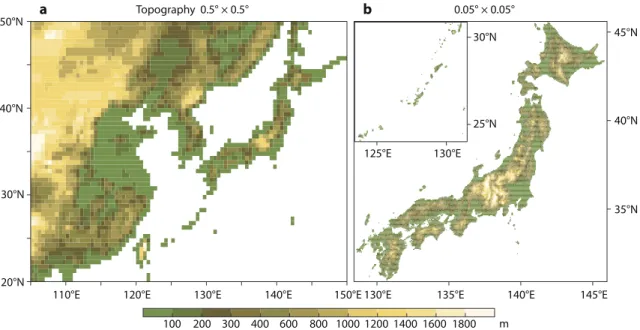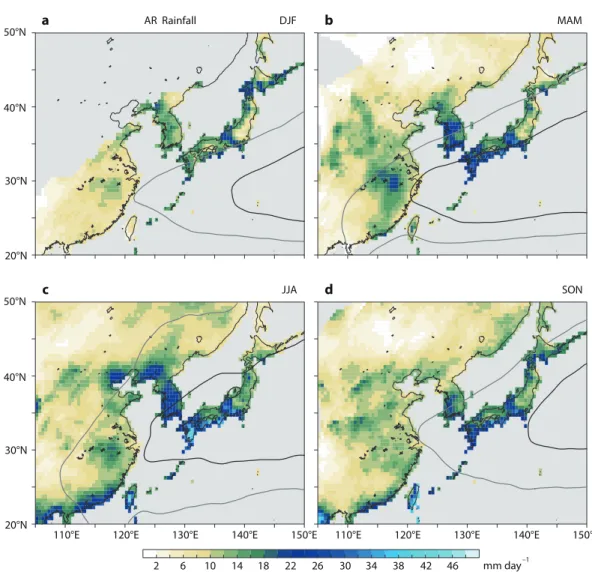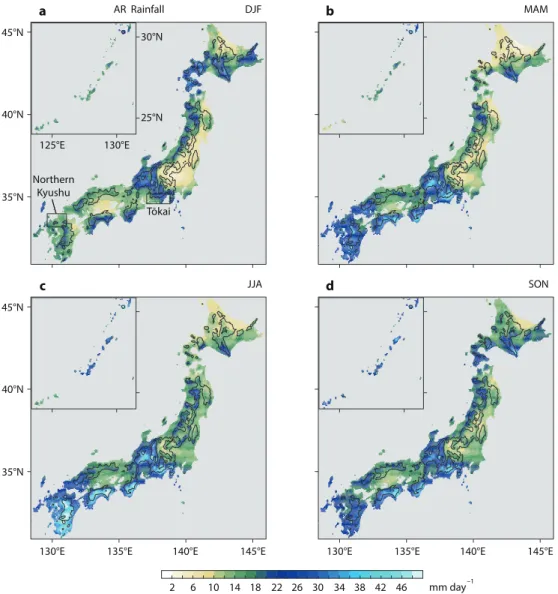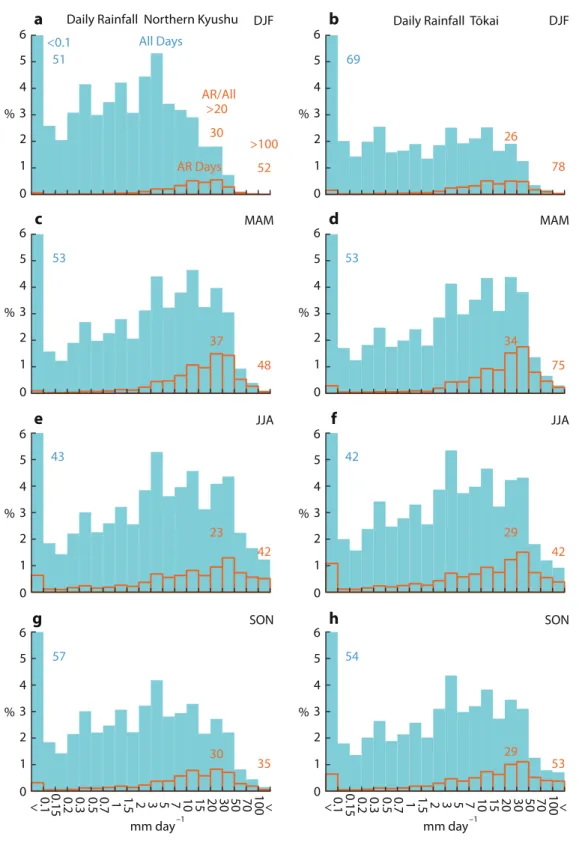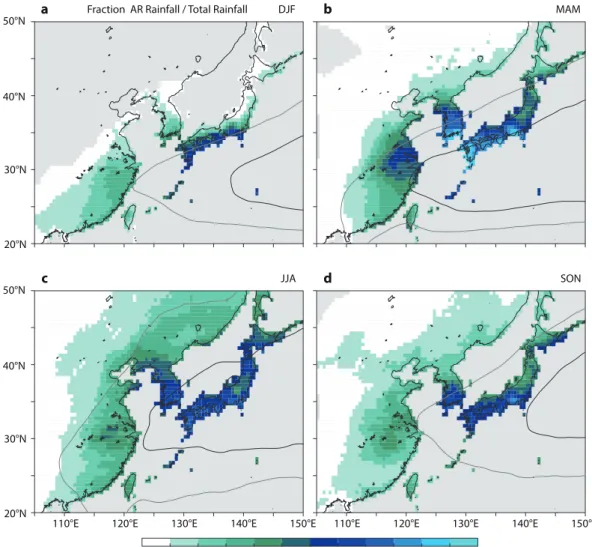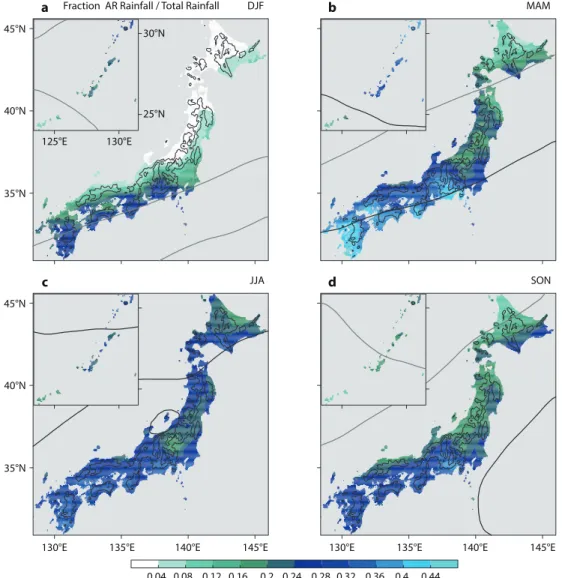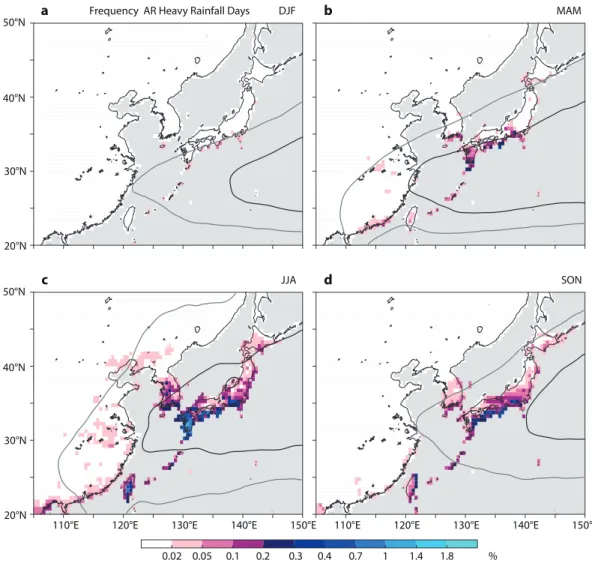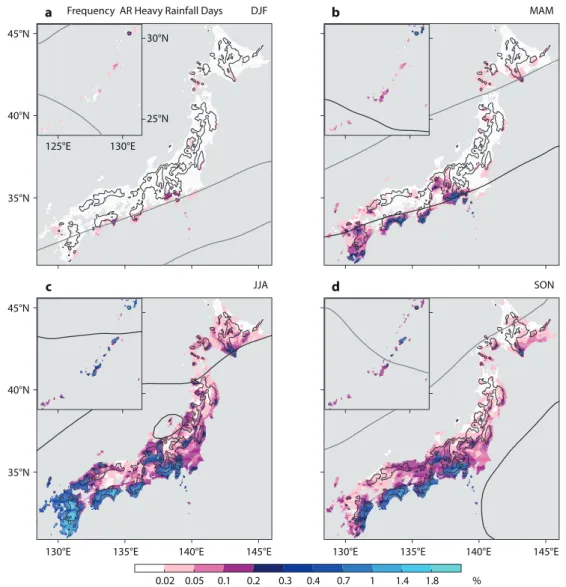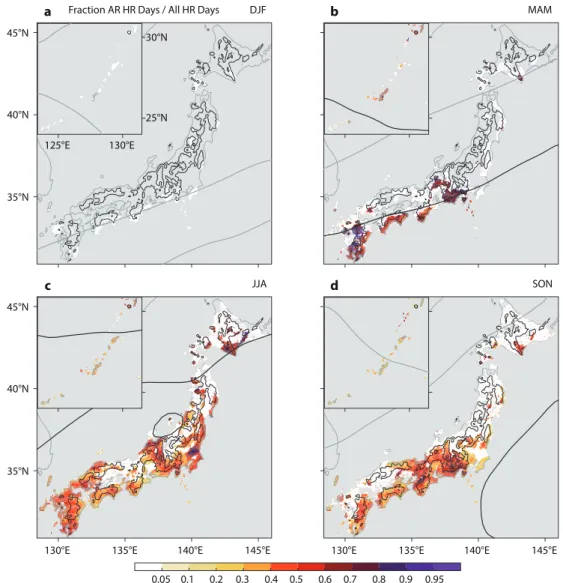Seas on At m
os pher i c Ri ver s and H
eavy Rai nf al l
over Eas t As i a
著者
KAM
AE Youi c hi , M
EI W
ei , XI E Shang- Pi ng
j our nal or
publ i c at i on t i t l e
J our nal of t he M
et eor ol ogi c al Soc i et y of J apan
vol um
e
95
num
ber
6
page r ange
411- 431
year
2017- 11
権利
( C) 2017, M
et eor ol ogi c al Soc i et y of J apan
U
RL
ht t p: / / hdl . handl e. net / 2241/ 00149341
1. Introduction
Meridional atmospheric circulation and large-scale atmospheric eddies advect water vapor poleward from the tropics and subtropics. The atmospheric water vapor transport is an essential component of the global hydrological cycle and energy budget (e.g., Peixoto and Oort 1992; Trenberth and Stepaniak 2003; Schnei-der et al. 2006). In the middle latitudes, meridional
Climatological Relationship between Warm Season Atmospheric Rivers
and Heavy Rainfall over East Asia
Youichi KAMAE
Faculty of Life and Environmental Sciences, University of Tsukuba, Tsukuba, Japan Scripps Institution of Oceanography, University of California San Diego, California, USA
Wei MEI
Department of Marine Sciences, University of North Carolina at Chapel Hill, North Carolina, USA and
Shang-Ping XIE
Scripps Institution of Oceanography, University of California San Diego, California, USA
(Manuscript received 30 May 2017, in inal form 29 August 2017)
Abstract
Eddy transport of atmospheric water vapor from the tropics is important for rainfall and related natural di-sasters in the middle latitudes. Atmospheric rivers (ARs), intense moisture plumes that are typically associated with extratropical cyclones, often produce heavy precipitation upon encountering topography on the west coasts of mid-latitude North America and Europe. ARs also occur over the northwestern Paciic and sometimes cause loods and landslides over East Asia, but the climatological relationship between ARs and heavy rainfall in this region remains unclear. Here we evaluate the contribution of ARs to the hydrological cycle over East Asia using high-resolution daily rainfall observations and an atmospheric reanalysis during 1958 – 2007. Despite their low occurrence, ARs account for 14 – 44 % of the total rainfall and 20 – 90 % of extreme heavy-rainfall events during spring, summer, and autumn. AR-related extreme rainfall is especially pronounced over western-to-southeastern slopes of terrains over the Korean Peninsula and Japan, owing to strong orographic effects and a stable direction of low-level moisture lows. A strong relationship between warm-season AR heavy rainfall and preceding-winter El Niño is identiied since the 1970s, suggesting the potential of predicting heavy-rainfall risk over Korea and Japan at seasonal leads.
Keywords ENSO; atmospheric river; Indo-western Paciic Ocean Capacitor; heavy rainfall
Corresponding author: Youichi Kamae, Faculty of Life and Environmental Sciences, University of Tsukuba, 1-1-1 Tennoudai, Tsukuba, Ibaraki 305-8572, Japan E-mail: kamae.yoichi.fw@u.tsukuba.ac.jp
water vapor transports by atmospheric disturbances, including tropical cyclones (e.g., Eckhardt et al. 2004; Knippertz and Wernli 2010; Boutle et al. 2011; Haw-croft et al. 2012; Newman et al. 2012), are critically important for land hydrology (e.g., heavy rainfalls)
and natural disasters (e.g., droughts, loods, and land -slides). Atmospheric rivers (ARs), narrow elongated water vapor plumes typically associated with extra-tropical cyclones, are frequently observed over the mid-latitude Northern and Southern Hemispheres
(es-pecially, over the Paciic and Atlantic Ocean; e.g., Zhu
and Newell 1998; Ralph et al. 2004; Gimeno et al.
2016; American Meteorological Society 2017). ARs
greatly impact water availability and natural disasters over the mid-latitude coastal regions; therefore, they have attracted much attention.
While ARs have been a focus of numerous case studies (e.g., Ralph et al. 2004, 2011; Bao et al. 2006; Stohl et al. 2008; Moore et al. 2012), their large-scale climatologies have been characterized recently using atmospheric reanalyses. Mundhenk et al. (2016) exam-ined the basin-wide climatology and variability of the
North Paciic ARs by applying an objective detection
algorithm (detailed in Section 2.2). Guan and Waliser (2015) provided a global climatology of AR frequen-cy, duration, and related rainfall for the time period
of 1997 – 2014 using observations and an atmospheric reanalysis. Recently, Kamae et al. (2017; hereafter, K17) showed that ARs also frequently develop over the northwestern Paciic and make landfall over East
Asia in addition to the west coasts of the continents as illustrated in previous studies (e.g., Ralph et al. 2004,
2006; Neiman et al. 2008; Lavers et al. 2012; Payne
and Magnusdottir 2014; Gimeno et al. 2016). ARs are
frequently observed over eastern China, the Korean
Peninsula, and Japan especially during summer. Hirota et al. (2016) related a Hiro shima heavy-rainfall event of August 2014 to an AR-like water vapor transport from the Indochina Peninsula. Interannual variability of summertime AR occurrence (note that “AR occurrence” in this paper does not mean genesis
but existence) over the northwestern Paciic is well
explained by the preceding-winter El Niño through
tropical atmosphere–ocean interactions and thus is highly predictable (K17; detailed below).
The role of ARs in cold season land hydrology over the west coasts of North America, Africa, and Europe has been extensively studied (e.g., Ralph et al. 2006;
Neiman et al. 2008; Dettinger et al. 2011; Lavers
et al. 2012; Dettinger 2013; Kim et al. 2013; Payne
and Magnusdottir 2014; Lavers and Villarini 2015;
Gimeno et al. 2016; Kingston et al. 2016). Over these
regions, landfalling ARs account for a large portion of the total climatological precipitation despite their limited frequency (e.g., Guan et al. 2010; Rutz et al.
2014). For example, Dettinger et al. (2011) found that AR-day rainfall accounts for 30 – 45 % of the total
rainfall over the west coast of North America during
1998 – 2008. More recently, Lavers and Villarini (2015)
depicted an AR contribution of a similar magnitude to the total rainfall over Western Europe and central and northeastern United States during the winter season.
While ARs may also play an important role in the warm-season (late spring to early autumn) hydrolog-ical cycle over East Asia, the extent to which ARs contribute to the total rainfall and to the occurrence of extreme heavy rainfall remains unclear. Summer is the rainy season over East Asia. Moreover, the rain- bearing East Asian summer monsoon (e.g., Ninomiya
and Murakami 1987; Tao and Chen 1987; Ninomiya
and Akiyama 1992; Sampe and Xie 2010) exhibits substantial seasonal-interannual variability because of
the inluence of both tropical forcing (e.g., the El Niño
Southern Oscillation; ENSO) and extratropical at-mospheric circulation (e.g., mid-latitude atat-mospheric teleconnections; Wu and Wang 2002; Ding et al. 2011;
Kosaka et al. 2012; He et al. 2017; and references
therein). In addition to typhoons from the
northwest-ern Paciic (e.g., Mei et al. 2015; Mei and Xie 2016),
a quasi-stationary Meiyu-Baiu rainband that extends
from southeast China to Japan from June to mid-July
is critically important for water resources and natural disasters in the regions.
Tropical climate variability, such as ENSO, strongly affects the interannual variability of the East Asian summer monsoon through the tropical western North
Paciic (TWNP) anticyclone (Xie et al. 2016 and references therein). K17 found that the interannual
variability of summertime AR occurrence over the
northwestern Paciic is largely controlled by the
preceding-winter ENSO through the Indo-western
Paciic ocean capacitor (IPOC) effect (e.g., Xie et al.
2009, 2016). In a post-El Niño spring, a westward
propagating ocean Rossby wave from the Paciic
Ocean warms the southwest Indian Ocean. The resul-tant anomalous cross-equatorial winds from the north Indian Ocean result in a north Indian Ocean warming and interact with the TWNP anticyclone. While the
equatorial Paciic sea surface temperature (SST)
signal dissipates before summer, the warm north
Indian Ocean and South China Sea and the TWNP
anticyclone are robustly observed in the post-El Niño
summers. The IPOC also inluences warm-season East
delayed impact of ENSO on the summertime Asian
climate. Through the IPOC, the enhanced southwester
-ly on the northwestern lank of the TWNP anticyclone
in the post-El Niño summer results in an increased
occurrence of summertime ARs over eastern China and Japan (Fig. 9 in K17). Frequent summertime ARs
possibly increase natural disaster risk through extreme heavy rainfalls over East Asia (e.g., Ogura et al. 1985; Kato 1998; Manda et al. 2014; Hirota et al. 2016;
K17). Despite numerous case studies, the contribution
of summertime ARs to extreme heavy rainfall over
East Asia needs to be quantiied climatologically via
statistical analysis of long-term observations.
This study evaluates the role of ARs in rainfall over East Asia using high-resolution meteorological obser-vations and reanalysis. We focus on the long-term sta-tistics over multidecadal periods. Our results indicate that East Asian ARs contribute to large fractions of the total rainfall and extreme rainfall events during spring, summer, and autumn. AR-induced heavy rainfalls tend to occur on the western-to-southeastern slopes of the terrains over the Korean Peninsula and Japan as
the direction of low-level moisture low is relatively
stable compared to typhoons. This study further
iden-tiies a strong ENSO control on interannual variability
in AR-induced warm-season heavy rainfall and hence seasonal predictability.
This paper is organized as follows. Section 2 de-scribes data and methods including an AR detection algorithm used in this study. Section 3 presents the climatology of AR rainfall and its fractional contribu-tion to the total rainfall over East Asia. We also show a climatological heavy-rainfall map accompanied with East Asian ARs. Section 4 evaluates the effect of ENSO on interannual variability of warm-season AR-related heavy rainfall over East Asia. In Section 5, we present a summary and discussion.
2. Data and methods
2.1 Observations and reanalysis
We use the high-resolution daily precipitation datasets produced by the Asian Precipitation—Highly- Resolved Observational Data Integration Toward Eval-uation of the Water Resources project (APHRODITE;
Yatagai et al. 2012), developed from thousands of me -teorological observation stations over Asia. This data-set has been widely used in evaluating continent-wide and regional rainfall climatology and its variability
(e.g., Yasutomi et al. 2011; Peña-Arancibia et al. 2013; Ren et al. 2013; Kamae et al. 2014; Lutz et al. 2014).
of 0.5° × 0.5° and APHRODITE for Japan (APHRO
JP) V1207 at a 0.05° × 0.05° resolution (Kamiguchi
et al. 2010). We use these two subsets to evaluate cli-matology, variability, and extreme values of regional
daily rainfall over East Asia (105 – 150°E, 20 – 50°N; Fig. 1a) and Japan (Fig. 1b), respectively. Note that
the ending time for the 24-hour accumulation of observed precipitation differs across regions. Daily
precipitation in China and Mongolia (Japan) are based on accumulation from 12UTC (15UTC) on the previ
-ous day to 12UTC (15UTC) on the day (e.g., Yatagai
et al. 2012). In this study, the daily precipitation data over East Asia are compared with four time steps of
six-hourly AR ields (from 18UTC on the previous day to 12UTC on the day) to composite AR-related
rainfall (see Section 2.2).
We also use SST data from HadISST (e.g., Rayner et al. 2003) at a 1.0° × 1.0° spatial resolution and
six-hourly (00UTC, 06UTC, 12UTC, and 18UTC) three-dimensional atmospheric ields from the Jap -anese Reanalysis for 55 years (JRA-55; Kobayashi
et al. 2015). We use sea level pressure (SLP) and three-dimensional speciic humidity and horizontal
wind at a spatial resolution of 1.25° × 1.25°. These variables are used to detect AR-like features, as
de-tailed in K17 and in Section 2.2. We focus on the time period 1958 – 2007, when there is an overlap between
the APHRODITE and JRA-55 data.
2.2 Detection of atmospheric river and associated rainfall
We evaluate climatology, variability, and extreme values of AR-related rainfall based on the high-res-olution daily rainfall dataset (Section 2.1) and
de-tected ARs from K17. K17 applied an AR detection
algorithm developed by Mundhenk et al. (2016) to three-dimensional atmospheric data derived from JRA-55. The original source code of the AR detection algorithm was provided by B. D. Mundhenk (see
an appendix of Mundhenk et al. 2016). K17 used six-hourly speciic humidity and horizontal wind to
calculate vertically integrated water vapor transport (IVT) between 300 and 1000 hPa levels at a 1.25° × 1.25° spatial resolution. The IVT is determined as below:
IVT=
1
∫
+1∫
1000300 2
1000
300 2
g qu dp g qv dp , (1)
to gravity, and u and v are zonal and meridional wind,
respectively. K17 referred to the anomalous IVT ield from its daily climatology (1958 – 2010) to exclude
effects of background seasonal cycle of tropospheric
water vapor content. By applying several criteria, K17
removed non-AR disturbances (e.g., tropical cyclones;
see Section 5) from the six-hourly IVT ield (see Fig. A2 of Mundhenk et al. 2016). First, an anomalous
threshold of 140 kg m−1 s−1 was used to detect intense moisture bands. Next, IVT bands with a small area
(< 7.8 × 105
km2) or short length (< 1,500 km) or small length/width ratio (< 1.325) were removed. In
addi-tion, east–west oriented IVT bands with a center of
mass equatorward of 20°N were also excluded from the analysis. A temporal persistence was not included
as a criterion, i.e., K17 did not examine persistence of
AR events but detected AR-like features in each time step individually. The IVT-based AR detection method has been widely applied to AR predictions and
clima-tological AR studies (e.g., Lavers et al. 2012; Nayack
et al. 2014; Guan and Waliser 2015; Mundhenk et al.
2016; K17). Note that quantitative results of our study
may be partly dependent on choices of AR detection criteria (see discussion in Section 5). More details of the detection method can be found in Mundhenk et al.
(2016) and K17.
The JRA-55-based six-hourly AR ields at a 1.25°
× 1.25° resolution are then linearly interpolated into 0.5° × 0.5° and 0.05° × 0.05° spatial resolutions and compared with land rainfall (Section 2.1) to composite
AR-related rainfall (see Fig. 1c in K17). We determine
that an AR exists at a given grid point on a given day if the AR is detected at least two out of four time steps
(i.e., 12 h out of 24 h) from 18UTC on the previous day to 12UTC on the day. We referred these four time
steps because a large part of rainfall observations over
East Asia were accumulated from 12UTC (15UTC) on the previous day to 12UTC (15UTC) on the day
(Section 2.1). A fractional contribution of ARs to total rainfall is derived through a comparison of rainfall accumulated during AR days to the total rainfall accu-mulation.
3. Climatology of AR-related rainfall over East Asia
3.1 AR frequency and AR rainfall
ARs bring a large amount of rainfall to East Asia.
Figure 2 shows the climatological seasonal-mean
rainfall averaged for the days during which ARs exist at individual grid points (Section 2.2). Wintertime
northeastern and western China is excluded from the Fig. 1. (a) Topography (m) at spatially 0.5° × 0.5° resolution (Row et al. 1995) over East Asia and (b) at 0.05° × 0.05°
analysis (Fig. 2a) because of the absence of ARs. Averaged spring-to-autumn rainfall for AR days (8 – 44
mm day−1) is much larger than climatological seasonal-
mean rainfall (1 – 8 mm day−1; e.g., Yatagai et al.
2009; Kamiguchi et al. 2010). In particular, spring-to-autumn AR rainfall is predominant over Taiwan,
coastal region of southern China, the Korean Penin
-sula, and Japan (14 – 44 mm day−1). Figure 3 shows
higher-resolution AR rainfall maps for Japan. AR rainfall is broadly observed from southwestern to
northern Japan with its peaks (18 – 48 mm day−1
) over western and central Japan from spring-to-autumn. As expected, AR rainfall exhibits a spatial pattern closely
related to topography. AR rainfall peaks are found on
the western-to-southeastern slopes of mountains (Fig.
1), i.e., southern and central Kyushu, western part of
the Chugoku region, southern Shikoku, southern part
of the Kii Peninsula, and central and southern parts
of central Japan including the Tōkai region (Fig. 3,
Supplement 1). The regional correspondence between AR rainfall and terrain is also found over Taiwan
(southern and eastern slopes of the Central Mountain
Range), the Korean Peninsula (western slopes of the
Sobaek Mountains and the Taebaek Mountains; Fig. 2,
Supplement 1), and smaller mountains over Japan (the Izu Peninsula, the Abukuma Mountains, the Kitakami
Fig. 2. Climatology of precipitation (mm day−1
Mountains, Mount Chōkai, the Shirakami Mountains,
northern part of the Ou Mountains, the Oshima
Pen-insula, and the Hidaka Mountains; Fig. 3, Supplement
1). These results indicate strong orographic effects (see Section 3.3).
Warm-season ARs bring a large amount of rainfall
especially over the Paciic coast of western and central Japan including the Tōkai region (Fig. 3). Figure 4
shows the histogram of the daily rainfall over northern
Kyushu and the Tōkai region. These two regions are
selected to represent the Japan Sea coast and the Pacif-ic coast regions, respectively (see Section 3.3). Over these regions, relatively weak rainfall (< 5 mm day−1) is frequent throughout the seasons while the frequency
of heavy rainfall (> 5 mm day−1) is increased during spring, summer, and autumn. Histogram for AR days
(orange bars in Fig. 4) is skewed to heavier rainfall than that for all days. Remarkable fractions (23 – 75 %)
of spring-to-autumn heavy (> 20 mm day−1) and extreme heavy (> 100 mm day−1) rainfall are observed on AR days. The skewed histogram indicates that risk of extreme heavy rainfall greatly increases when ARs occur (see Section 3.2).
East Asian ARs contribute substantially to the
cli-matological rainfall. Figures 5 and 6 show the fraction
of AR rainfall to the seasonal total rainfall over East
Asia. Despite the limited frequency (6 – 20 %), ARs explain a large fraction (14 – 44 %) of climatological
rainfall especially over the Korean Peninsula and
western Japan in spring (20 – 44 %; Fig. 5b). The AR
contribution to total rainfall exhibits a clear season-ality largely owing to the seasonal variation of AR
occurrence over the northwestern Paciic (K17). Com -pared to winter, springtime AR occurrence is much increased over East Asia, consistent with the increase
in the AR contribution over eastern China, the Korean Peninsula, and Japan (Fig. 5b). Over the mid-latitude East Asia (30 – 50°N), the fractional contribution is greater in spring than in summer (Figs. 5b, c, 6b, c)
despite more frequent AR occurrence in summer than in spring. In contrast to spring, the Meiyu-Baiu rainband over East Asia from June to mid-July greatly
contributes to summertime rainfall over eastern China,
the Korean Peninsula, and Japan with the exception
of Hokkaido. During autumn, northwestern Paciic ty -phoons occasionally bring heavy rainfall to East Asia
(e.g., Ren et al. 2006; Prat and Nelson 2013, 2017).
The dominant contributions of the Meiyu-Baiu rain-band and typhoons in summer and autumn result in a lower AR contribution during these seasons compared
to spring (Figs. 4, 5, 6). Over southern China, Taiwan,
and the Ryukyu Islands, AR contributions are
gener-ally smaller than those at higher latitudes (30 – 45°N)
because of lower AR frequency and more frequently
approaching typhoons over these regions (20 – 30°N; Figs. 5, 6). Note that typhoons and ARs sometimes
exhibit complex interactions over East Asia (see Section 5 and Supplement 2). In the next subsection, we examine statistical characteristics of heavy rainfall accompanied with ARs.
seasonal-mean rainfall and increase natural disaster
risk related to heavy rainfall. Figure 7 shows the
frequency of extreme heavy rainfall (> 100 mm day−1) accompanied with ARs over East Asia. The AR heavy rainfall is especially frequent over Taiwan, the Korean Peninsula, the Ryukyu Islands, and western and
cen-tral Japan (0.2 – 1.2 %) and induces natural disasters during the warm season (K17). The heavy rainfall peaks in summer (Fig. 7c), largely consistent with the
seasonal variation of the large-scale AR occurrence
over East Asia (K17). In contrast, the AR heavy rain -fall almost never occurs over broad areas of the
Eur-sponds to only one day for the 50 years).
Similar to the mean rainfall (Fig. 3), the AR-related
heavy rainfall also manifests strong effects of regional
terrains. Figure 8 shows the frequency of AR heavy
rainfall over Japan. Observed AR heavy rainfall over
the Paciic coast of western and central Japan displays its peak in summer (0.3 – 1.4 % over Kyusyu, Shikoku,
the Kii Peninsula, and central and southern parts of central Japan). In autumn, frequencies of large-scale ARs and regional AR heavy rainfall on the western slopes of mountains over western Japan (e.g., western
Kyushu and western part of the Chugoku region) are
greatly reduced compared to summer (Fig. 8d). In
addition to western and central Japan, regional peaks are also found over northern Japan (e.g., the Kitakami Mountains, the Oshima Peninsula, and the Hidaka Mountains). The warm-season heavy rainfall on the steep terrains greatly increases the risk of natural
disasters such as loods and landslides over those
regions.
ARs explain a large fraction of spring-to-autumn
heavy rainfall over East Asia. Figures 9 and 10 show
fractions of AR heavy rainfall days to total heavy rainfall days. Despite the dominant role of typhoons in the warm-season extreme rainfall events over East Asia (e.g., Prat and Nelson 2016), ARs substantially contribute to the heavy rainfall events especially in
spring and summer. During spring, 40 – 95 % of heavy
rainfall events over the Paciic coast of western and
central Japan are observed during AR days despite the
limited frequency of 18 – 20 % (Figs. 4d, 9b, 10b). The
AR heavy rainfalls are widely observed in summer:
AR days account for 20 – 90 % of the total heavy
rainfall days over Taiwan, the Ryukyu Islands, the
Korean Peninsula, and western Japan (Figs. 4e, 9c) and 50 – 90 % over the Paciic coast of northern Japan (e.g., the Hidaka Mountains; Fig. 10c). Occasionally
approaching typhoons in autumn contribute to a large fraction of heavy-rainfall events over East Asia (Prat and Nelson 2016), resulting in a lower relative fraction of AR heavy rainfall over western Japan and
the Paciic coast of northern Japan than in summer (Figs. 9d, 10d). However, 20 – 80 % of heavy rainfalls
over the south coast of Korea and western and central
Fig. 7. Similar to Fig. 2, but for frequency (%) of AR heavy rainfall days (> 100 mm day−1
Japan are still associated with ARs.
The above results indicate that the anomalously enhanced water vapor transports related to ARs (e.g.,
Fig. 1 in K17) contribute greatly to the East Asian
mean and extreme rainfall. The spatial patterns of AR mean and extreme rainfall largely result from the large-scale variations of seasonal AR occurrence and regional terrains, suggesting that AR-induced natural
disaster risk tends to be conined to particular regions
(i.e., western-to-southeastern slopes of mountains). In the next subsection, we further examine relationships
between AR-related water vapor lows, regional ter -rains, and AR rainfall.
3.3 Dependence of regional AR rainfall on wind di-rection
Over East Asia, low-level moisture lows accom -panied with ARs possibly induce heavy rainfall when they encounter the meridionally running mountains
over the Korean Peninsula and Japan (Fig. 1). From
a geographical view, the mountains over Japan
elon-gated in the southwest–northeast direction (Fig. 1b)
strongly affect the climatological spatial patterns of rainfall and snowfall (e.g., cold northwesterly asso-ciated with the East Asian winter monsoon induces a large amount of snowfall on the western slopes of mountains over Japan, e.g., Manabe 1958; Ninomiya 1968; Ueda et al. 2015). In this section, we examine which direction of low-level wind is responsible for
the regional AR rainfall over Japan (Section 2.1).
Figures 11a, 11c, 11e, and 11g show spatial patterns of
weighted-mean wind direction contributing to regional AR rainfall. The wind direction is derived as follows:
∑ ∑
∑ ∑
ppu
p v
p
AR AR AR
AR AR AR
, , (2)
where u and v is the large-scale daily-mean zonal and meridional wind from JRA-55 averaged between 800 and 1000 hPa levels, and p is the daily precipitation from APHRO JP. Subscript of AR indicates those of AR days. The atmospheric variables from JRA-55 were linearly interpolated into a 0.05° × 0.05°
resolu-tion before any further analyses. Note that u and v
indicate a large-scale atmospheric circulation ield.
The resultant wind vector of Eq. (2) indicates a
dom-inant large-scale low-level wind ield accompanied
with regional AR rainfall. Spatial patterns of the wind
direction shown in Figs. 11c, 11e, and 11g are closely
related to regional terrains, i.e., a westerly-to-south-westerly wind favors spring, summer, and autumn AR rainfall over western Kyushu and the Japan Sea coast, whereas a southwesterly-to-southerly wind promotes
AR rainfall over eastern Kyushu and the Paciic coast
of western, central, and northern Japan. The wind
direction map shown in Figs. 11c, 11e, and 11g can
be clearly divided into two AR rainfall regimes: the
Fig. 9. Similar to Fig. 2, but for fraction of AR heavy rainfall days (> 100 mm day−1
Japan Sea coast region (westerly regime) and the
Pa-ciic coast region (southerly regime).
Low-level moisture lows accompanied with East
Asian ARs are mostly in the westerly-to-southerly
di-rections (e.g., Hirota et al. 2016; K17). Therefore, the
wind direction accompanied with AR heavy rainfall is
quite stable during spring, summer, and autumn (Figs. 11c, e, g). Such a wind–rainfall relationship is distinct from that related to non-AR rainfall events. Figures
11b, 11d, 11f, and 11h show the wind direction map associated with all rainfall events instead of AR events. The wind direction is derived as below:
∑ ∑
∑ ∑
pup , pvp. (3)
The summertime wind direction map (Fig. 11f) is similar to Fig. 11e, while other seasons exhibit
different patterns. In winter, cold northwesterly from the Eurasian continent associated with the East Asian winter monsoon absorbs a large amount of moisture from the Japan Sea (Manabe 1958; Ninomiya 1968;
Ueda et al. 2015). The modiied air mass induces a heavy rainfall and snowfall (Fig. 11b), greatly contrib -uting to the seasonal-mean climatological precipitation
Fig. 10. Similar to Fig. 6, but for fraction of AR heavy rainfall days (> 100 mm day−1
especially in autumn. Northwestward-to-westward moving rainbands in the north part of typhoons bring heavy rainfall to western and eastern Japan especially
on eastern and southern slopes of mountains (Fig.
11h). The great contribution of southeasterly wind is also found on eastern slopes of mountains over the
Paciic coast of western Japan in spring and summer (Figs. 11d, f).
The above results suggest that natural disaster risk related to AR heavy rainfall is especially high over the
western-to-southeastern slopes of mountains (Figs. 7, 8) owing to the associated stable moisture low in
contrast to highly variable wind directions accom-panied with other disturbances including typhoons.
Therefore, anomalously high risk of loods and land -slides due to AR heavy rainfall would be predicable if we could accurately predict variations of the East Asian AR frequency and intensity. In the next section, we examine the interannual variability of AR heavy rainfall over East Asia, and the physical relationship with AR frequency and ENSO variability.
4. Interannual variability
4.1 Anomalous AR frequency in post-El Niño summer over East Asia
The anomalously intense moisture low accom -panied with the spring-to-autumn AR brings heavy rainfall to East Asia, especially over the Korean Peninsula and Japan. The seasonal-mean frequency of heavy-rainfall events can vary substantially because
of variations in large-scale AR ields. K17 found that
summertime AR occurrence over East Asia is strongly
affected by eastern equatorial Paciic SST anomalies
during the preceding winter through the atmospheric circulation anomalies over the TWNP and East Asia. In the post-El Niño summer, anomalous anticyclone
over the TWNP favored by the IPOC effect (Section 1)
enhances low-level southwesterly on the northwestern
lank of anticyclone and increases occurrence of ARs over eastern China, the Korean Peninsula, and Japan. However, the western North Paciic response to El
Niño forcing is not seasonally uniform from spring-to-autumn. This section examines seasonally asymmetric response of East Asian atmospheric circulation and AR activity in post-El Niño spring-to-autumn.
Figure 12 shows the regression of East Asian atmo
-spheric circulation in late spring (April – May – June; AMJ) and late summer (July – August – September; JAS) onto the preceding-winter (November – Decem
-ber – January; NDJ) Niño3.4 (5°S – 5°N, 170 – 120°W)
index during 1979 – 2007. Supplement 3 provides
regression map for an earlier period. The anomalous TWNP anticyclone persists from spring to summer
al-though the equatorial Paciic SST anomalies dissipate before summer. From El Niño winter to spring, anom -alous northeasterly enhances wind speed over the TWNP region, resulting in a local Wind-Evaporation- SST (WES) feedback (Xie and Philander 1994) that
sustains the positive SLP anomaly (Wang et al. 2000). The SLP anomaly in AMJ favors the southwesterly anomaly on the northwestern lank of the anticyclone including eastern China and Japan, thus increasing water vapor transport and frequency of AR (Fig. 12a).
In summer, East Asian atmospheric circulation is affected by warm SST anomalies in the North Indian
Ocean and the East China Sea. Eastward-propagating
Kelvin waves from the warm Indian Ocean favors an anomalous TWNP anticyclone in post-El Niño
summer (Fig. 12b; Xie et al. 2009) despite an absence of the eastern equatorial Paciic SST forcing. The summertime positive SLP anomaly and suppressed convective activity around the Philippines (15 – 20°N) favor the PJ pattern (Nitta 1987): negative and positive SLP anomalies over Japan (35°N) and the Okhotsk Sea (55°N), respectively (Fig. 12b). In contrast to late spring (Fig. 12a), the PJ pattern dominates in summer
because of the prevailing monsoon westerly that is a necessary condition for the atmospheric teleconnec-tion (Kosaka et al. 2013; Xie et al. 2016). The
merid-ional SLP gradient between 20°N and 35°N results in southwesterly anomalies over eastern China, Korea, and the south of Japan (Fig. 12b). The enhanced
southwesterly moisture transport has recently been related to increased rainfall in mountainous central
China in post-El Niño summers (Hu et al. 2017). The
anomalous southwesterly winds favor AR occurrence
over the mid-latitude East Asia except the Paciic
coast of western Japan where northwesterly wind
anomalies prevail (Fig. 12b). In the next subsection,
we further examine relationship between ENSO and occurrence of regional AR heavy rainfall.
4.2 AR-related heavy rainfall in post-El Niño summer
The post-El Niño atmospheric circulation and AR frequency over East Asia shown above also affect
regional heavy rainfall occurrence. Figure 13 shows
anomalies in frequency of AR heavy-rainfall events (> 100 mm day−1) in post-El Niño spring and summer. The spatial pattern of AR heavy-rainfall frequency are largely consistent with those of AR frequency: large
positive anomalies over the Paciic coast of western Japan in AMJ (Figs. 13a, b) and on the western slope
of the Taebaek Mountains on the Korean Peninsula and the Japan Sea coast of western and central Japan
in JAS (Figs. 13c, d). The anomalous southwesterly over the Ryukyu Islands and the Paciic coast of
western Japan in AMJ favors occurrences of ARs
(1.6 – 3.0 % K−1) and AR heavy rainfall (0.1 – 0.5 %
K−1; statistically signiicant over the Ryukyu Islands, southern Kyushu, southeastern Shikoku and southern
part of the Kii Peninsula; Figs. 13a, b). Positive anom -alies in AR frequency are broadly found over East
Asia, while the statistically signiicant anomaly in AR
heavy rainfall occurrence is limited to narrow regions. Over the Japan Sea coast, the AR-related low-level
westerly is responsible for the AR heavy rainfall (Fig.
11). The southerly-to-southeasterly anomaly in AMJ
(Fig. 12a) is not favorable for heavy rainfall over this region (Figs. 13a, b). A statistically signiicant increase in AR heavy-rainfall frequency (0.05 % K−1
) is found over the Oshima Peninsula although the pos-itive AR frequency anomaly is smaller than that over the lower latitudes.
The tripole SLP pattern in JAS results in more
complex patterns of low-level circulation and AR
frequency than in AMJ (Fig. 12), leading to a distinct
pattern of AR heavy rainfall occurrence. The large
positive anomaly in AR heavy-rainfall frequency (0.1 – 0.4 % K−1), statistically signiicant over the Japan
Sea coast of western and central Japan (Figs. 13c, d),
is largely consistent with the predominant positive anomaly in the large-scale AR frequency over the
middle latitude (35°N). Over the Paciic coast of
western Japan, the southerly wind anomaly is
respon-sible for the anomalous heavy rainfall (Fig. 11e). The low-level northwesterly anomaly in JAS (Fig. 12b)
is not instrumental in increasing the frequency of AR
and AR heavy rainfall (Figs. 13c, d). These results
suggest that the anomalous occurrence of warm- season heavy rainfall accompanied with ARs is largely explained by the response of the East Asian atmo-spheric circulation to preceding-winter ENSO forcing, therefore possibly predictable. Note that increasing AR heavy rainfall over central and eastern Hokkaido
in JAS (0.02 – 0.1 % K−1
) is not simply explained by the large-scale AR frequency and low-level circulation (easterly anomaly). Anomalously intense ARs with limited frequency may contribute to this anomalous heavy rainfall.
5. Summary and discussion
large amount of rainfall to East Asia, and account
for 14 – 44 % of spring-to-autumn rainfall over Taiwan, coastal region of southern China, the Korean
Peninsula, and western and central Japan. Regional mountains over East Asia exert strong orographic effects, resulting in much more AR heavy rainfall on the western-to-southeastern slopes than the eastern- to-northern slopes owing to prevailing westerly-to-
southerly low-level moisture lows. In particular, the East Asian ARs explain 20 – 90 % of
spring-to-autumn heavy-rainfall events over Taiwan, the Ryukyu
Islands, the Korean Peninsula, and western and central Japan. Risk hotspots for AR-related natural
disasters are conined to narrow regions because of the
stable wind direction, unlike those induced by other synoptic disturbances including typhoons. The large interannual variations of warm-season AR occurrence and low-level atmospheric circulation over East Asia related to ENSO induce anomalously frequent heavy rainfall over the Korean Peninsula and Japan. In post-El Niño spring, anomalous southwesterlies from the tropics increases the frequency of AR-related heavy
Fig. 13. Spatial patterns of regression coeficients of (a) AMJ and (c) JAS frequency of AR heavy rainfall days (shading; % K−1) and AR frequency (contour; gray indicates ± 0.4 % K−1, black indicates ± 1.6 % K−1
rainfall over the Paciic coasts of western Japan. In
late summer, the PJ pattern and associated low-level
low reduce the frequency of AR heavy rainfall over the Paciic coasts of western Japan but increase it
over the Korean Peninsula and the Japan Sea coasts of western and central Japan. The strong coupling be-tween ENSO and the stable wind direction sheds light on the predictability of anomalous natural disaster risk due to warm-season AR activity over East Asia.
The quantitative results for the climatology of AR rainfall and its relative contribution to total rainfall may be partly dependent on AR detection methods. A variety of detection methods have been proposed in previous studies (e.g., Gimeno et al. 2014): percentile-
based (e.g., Lavers et al. 2012; Nayack et al. 2014) or ixed IVT criterion (e.g., Rutz et al. 2014; Mundhenk
et al. 2016) with various other criteria, including length, length/width ratio, and orientation of moisture
low. These differences may quantitatively affect
the results. Guan and Waliser (2015) compared AR features detected on the basis of different methods and concluded that the results are similar but sensitive to a particular criterion (such as length of detected feature). Mundhenk et al. (2016) showed similar
climatology of North Paciic AR occurrence as in
Guan and Waliser (2015) although they employed different detection methods and used different atmo-spheric datasets. These results suggest that the AR contribution to warm-season heavy rainfall over East Asia and its interannual variability examined in this study should be qualitatively similar when a different method is adopted. It is also important to evaluate effects of transitioning tropical cyclones and remote impacts of typhoons to East Asian rainfall (e.g.,
Galarneau et al. 2010; Yoshida and Itoh 2012; Hirata
and Kawamura 2014; see Supplement 2) although we excluded direct impact of typhoons (Sections 2.2 and
3.3). Further studies on the interactions of large-scale
East Asian monsoon, ARs, typhoons, and tropical and mid-latitude climate variabilities are needed to im-prove our understanding of East Asian heavy rainfall and its seasonal predictability.
K17 showed that variations in summertime AR occurrence over the northwestern Paciic are largely
explained by the preceding-winter ENSO variability and have high predictability. Our results further reveal that the occurrence of spring-to-autumn heavy rainfall accompanied with ARs is also closely related to the preceding-winter ENSO, and the relationship is seasonally asymmetric between spring and summer. In addition, regional variability of AR heavy rainfall occurrence is largely controlled by AR occurrence
and low-level wind direction relative to East Asian terrains. In this study, we focus only on the relation-ship between AR-related heavy rainfall and ENSO
after 1979. The coupling between East Asian climate
and ENSO varies on interdecadal time scales (e.g., Xie et al. 2010; Kubota et al. 2016), resulting in a distinct pattern of anomaly in AR occurrence for the
period prior to the 1970s (Supplement 3). Further
investigations on interdecadal variability of tropical
atmosphere–ocean interactions and associated tele -connections are needed for more reliable predictions of risk of AR-related natural disasters over the mid- latitude East Asia.
Supplements
Supplement 1 provides geographical names over the Korean Peninsula and Japan used in this study. Supplement 2 shows examples of local and remote effects of typhoons on East Asian ARs. Supplement 3 provides discussion on interdecadal variability of the
East Asian AR–ENSO coupling. Acknowledgments
We are grateful to Dr. T. Sato and two anonymous reviewers for their constructive comments. This work was supported by JSPS KAKENHI Grant Numbers
17K14388 and 17K01223 and the Integrated Research Program for Advancing Climate Models (TOUGOU program) from the Ministry of Education, Culture,
Sports, Science and Technology (MEXT), Japan.
References
American Meteorological Society, 2017: Atmospheric river. Glossary of Meteorology. Amer. Meteor. Soc. [Avail-able at http://glossary.ametsoc.org/wiki/Atmospheric_ river.]
Bao, J.-W., S. A. Michelson, P. J. Neiman, F. M. Ralph, and J. M. Wilczak, 2006: Interpretation of enhanced inte-grated water vapor bands associated with extratropical cyclones: Their formation and connection to tropical moisture. Mon. Wea. Rev., 134, 1063–1080.
Boutle, I. A., S. E. Belcher, and R. S. Plant, 2011: Moisture transport in midlatitude cyclones. Quart. J. Roy. Meteor. Soc., 137, 360–373.
Dettinger, M. D., 2013: Atmospheric rivers as drought busters on the U.S. West Coast. J. Hydrometeor., 14, 1721–1732.
Dettinger, M. D., F. M. Ralph, T. Das, P. J. Neiman, and D. R. Cayan, 2011: Atmospheric rivers, loods, and the water resources of California. Water, 3, 445–478. Ding, Q., B. Wang, J. M. Wallace, and G. Branstator, 2011:
N. Spichtinger, 2004: A 15-year climatology of warm conveyor belts. J. Climate, 17, 218–237.
Galarneau, Jr., T. J., L. F. Bosart, and R. S. Schumacher, 2010: Predecessor rain events ahead of tropical cy-clones. Mon. Wea. Rev., 138, 3272–3297.
Gimeno, L., R. Nieto, M. Vázquez, and D. A. Lavers, 2014: Atmospheric rivers: A mini-review. Front. Earth Sci., 2, 2.1–2.6.
Gimeno, L., F. Dominguez, R. Nieto, R. Trigo, A. Drumond, C. J. C. Reason, A. S. Taschetto, A. M. Ramos, R. Kumar, and J. Marengo, 2016: Major mechanisms of atmospheric moisture transport and their role in extreme precipitation events. Ann. Rev. Environ. Res., 41, 117–141.
Guan, B., and D. E. Waliser, 2015: Detection of atmospheric rivers: Evaluation and application of an algorithm for global studies. J. Geophys. Res., 120, 12514–12535. Guan, B., N. P. Molotch, D. E. Waliser, E. J. Fetzer, and P.
J. Neiman, 2010: Extreme snowfall events linked to atmospheric rivers and surface air temperature via sat-ellite measurements. Geophys. Res. Lett., 37, L20401, doi:10.1029/2010GL044696.
Hawcroft, M. K., L. C. Shaffrey, K. I. Hodges, and H. F. Dacre, 2012: How much Northern Hemisphere pre-cipitation is associated with extratropical cyclones? Geophys. Res. Lett., 39, L24809, doi:10.1029/2012GL 053866.
He, S., Y. Gao, F. Li, H. Wang, and Y. He, 2017: Impact of Arctic Oscillation on the East Asian climate: A review. Earth Sci. Rev., 164, 48–62.
Hirata, H., and R. Kawamura, 2014: Scale interaction be-tween typhoons and the North Paciic subtropical high and associated remote effects during the Baiu/Meiyu season. J. Geophys. Res., 119, 5157–5170.
Hirota, N., Y. N. Takayabu, M. Kato, and S. Arakane, 2016: Roles of an atmospheric river and a cutoff low in the extreme precipitation event in Hiroshima on 19 August 2014. Mon. Wea. Rev., 144, 1145–1160. Hu, K., S.-P. Xie, and G. Huang, 2017:
Orographically-anchored El Niño effect on summer rainfall in central China. J. Climate, in press, doi:10.1175/JCLI-D-17-0312.1.
Kamae, Y., M. Watanabe, M. Kimoto, and H. Shiogama, 2014: Summertime land-sea thermal contrast and atmospheric circulation over East Asia in a warming climate–Part I: Past changes and future projections. Climate Dyn., 43, 2553–2568.
Kamae, Y., W. Mei, S.-P. Xie, M. Naoi, and H. Ueda, 2017: Atmospheric rivers over the Northwestern Paciic: Climatology and interannual variability. J. Climate, 30, 5605–5619.
Kamiguchi, K., O. Arakawa, A. Kitoh, A. Yatagai, A. Hamada, and N. Yasutomi, 2010: Development of APHRO_JP, the irst Japanese high-resolution daily precipitation
Kato, T., 1998: Numerical simulation of the band-shaped torrential rain observed over southern Kyushu, Japan on 1 August 1993. J. Meteor. Soc. Japan, 76, 97–128. Kim, J., D. E. Waliser, P. J. Neiman, B. Guan, J.-M. Ryoo,
and G. A. Wick, 2013: Effects of atmospheric river landfalls on the cold season precipitation in Califor -nia. Climate Dyn., 40, 465–474.
Kingston, D. G., D. A. Lavers, and D. M. Hannah, 2016: Floods in the Southern Alps of New Zealand: The importance of atmospheric rivers. Hydrol. Processes, 30, 5063–5070.
Knippertz, P., and H. Wernli, 2010: A Lagrangian clima -tology of tropical moisture exports to the Northern Hemispheric extratropics. J. Climate, 23, 987–1003. Kobayashi, S., Y. Ota, Y. Harada, A. Ebita, M. Moriya, H.
Onda, K. Onogi, H. Kamahori, C. Kobayashi, H. Endo, K. Miyaoka, and K. Takahashi, 2015: The JRA-55 Reanalysis: General speciications and basic characteristics. J. Meteor. Soc. Japan, 93, 5–48. Kosaka, Y., J. S. Chowdary, S.-P. Xie, Y.-M. Min, and J.-Y.
Lee, 2012: Limitations of seasonal predictability for summer climate over East Asia and the Northwestern Paciic. J. Climate, 25, 7574–7589.
Kosaka, Y., S.-P. Xie, N.-C. Lau, and G. A. Vecchi, 2013: Origin of seasonal predictability for summer climate over the Northwestern Paciic. Proc. Natl. Acad. Sci. USA, 110, 7574–7579.
Kubota, H., Y. Kosaka, and S.-P. Xie, 2016: A 117-year long index of the Paciic-Japan pattern with application to interdecadal variability. Int. J. Climatol., 36, 1575– 1589.
Lavers, D. A., and G. Villarini, 2015: The contribution of atmospheric rivers to precipitation in Europe and the United States. J. Hydrol., 522, 382–390.
Lavers, D. A., G. Villarini, R. P. Allan, E. F. Wood, and A. J. Wade, 2012: The detection of atmospheric rivers in at-mospheric reanalyses and their links to British winter loods and the large-scale climatic circulation. J. Geo-phys. Res., 117, D20106, doi:10.1029/2012JD018027. Lutz, A. F., W. W. Immerzeel, A. B. Shrestha, and M. F. P.
Bierkens, 2014: Consistent increase in High Asia’s runoff due to increasing glacier melt and precipitation. Nat. Climate Change, 4, 587–592.
Manabe, S., 1958: On the estimation of energy exchange be-tween the Japan Sea and the atmosphere during winter based upon the energy budget of both the atmosphere and the sea. J. Meteor. Soc. Japan, 36, 123–134. Manda, A., H. Nakamura, N. Asano, S. Iizuka, T. Miyama, Q.
Moteki, M. K. Yoshioka, K. Nishii, and T. Miyasaka, 2014: Impacts of a warming marginal sea on torrential rainfall organized under the Asian summer monsoon. Sci. Rep., 4, 5741, doi:10.1038/srep05741.
1970s. Nat. Geosci., 9, 753–757.
Mei, W., S.-P. Xie, M. Zhao, and Y. Wang, 2015: Forced and internal variability of tropical cyclone track density in the western North Paciic. J. Climate, 28, 143–167. Moore, B. J., P. J. Neiman, F. M. Ralph, and F. E. Barthold,
2012: Physical processes associated with heavy looding rainfall in Nashville, Tennessee, and vicinity during 1–2 May 2010: The role of an atmospheric river and mesoscale convective systems. Mon. Wea. Rev., 140, 358–378.
Mundhenk, B. D., E. A. Barnes, and E. D. Maloney, 2016: All-season climatology and variability of atmospheric river frequencies over the North Paciic. J. Climate, 29, 4885–4903.
Nayak, M. A., G. Villarini, and D. A. Lavers, 2014: On the skill of numerical weather prediction models to fore-cast atmospheric rivers over the central United States. Geophys. Res. Lett., 41, 4354–4362.
Neiman, P. J., F. M. Ralph, G. A. Wick, J. D. Lundquist, and M. D. Dettinger, 2008: Meteorological characteristics and overland precipitation impacts of atmospheric rivers affecting the west coast of North America based on eight years of SSM/I satellite observations. J. Hydrometeor., 9, 22–47.
Newman, M., G. N. Kiladis, K. M. Weickmann, F. M. Ralph, and P. D. Sardeshmukh, 2012: Relative contri-butions of synoptic and low-frequency eddies to time-mean atmospheric moisture transport, including the role of atmospheric rivers. J. Climate, 25, 7341–7361. Ninomiya, K., 1968: Heat and water budget over the Japan
Sea and the Japan Islands in winter season. J. Meteor. Soc. Japan, 46, 343–372.
Ninomiya, K., and T. Murakami, 1987: The early summer rainy season (Baiu) over Japan. Monsoon Meteo-rology. Chang, C.-P., and T. N. Krishnamurti (eds.), Oxford University Press, Oxford, 93–121.
Ninomiya, K., and T. Akiyama, 1992: Multiscale features of Baiu, the summer monsoon over Japan and the East Asia. J. Meteor. Soc. Japan, 70, 467–495.
Nitta, T., 1987: Convective activity in the tropical western Paciic and their impact on the Northern Hemisphere summer circulation. J. Meteor. Soc. Japan, 65, 373– 390.
Ogura, Y., T. Asai, and K. Dohi, 1985: A case study of a heavy precipitation event along the Baiu front in northern Kyushu, 23 July 1982: Nagasaki heavy rain-fall. J. Meteor. Soc. Japan, 63, 883–900.
Payne, A. E., and G. Magnusdottir, 2014: Dynamics of landfalling atmospheric rivers over the North Paciic in 30 years of MERRA reanalysis. J. Climate, 27, 7133–7150.
Peña-Arancibia, J. L., A. I. J. M. van Dijk, L. J. Renzullo, and M. Mulligan, 2013: Evaluation of precipitation estimation accuracy in reanalyses, satellite products and an ensemble method for regions in Australia and South and East Asia. J. Hydrometeor., 14, 1323–1333.
Peixoto, J. P., and A. H. Oort, 1992: Physics of Climate. American Institute of Physics, New York, USA, 520 pp.
Prat, O. P., and B. R. Nelson, 2013: Mapping the world’s tropical cyclone rainfall contribution over land using the TRMM multi-satellite precipitation analysis. Water Resour. Res., 49, 7236–7254.
Prat, O. P., and B. R. Nelson, 2016: On the link between tropical cyclones and daily rainfall extremes derived from global satellite observations. J. Climate, 29, 6127–6135.
Ralph, F. M., P. J. Neiman, and G. A. Wick, 2004: Satellite and CALJET aircraft observations of atmospheric rivers over the eastern North Paciic Ocean during the winter of 1997/98. Mon. Wea. Rev., 132, 1721–1745. Ralph, F. M., P. J. Neiman, G. A. Wick, S. I. Gutman, M.
D. Dettinger, D. R. Cayan, and A. B. White, 2006: Flooding on California’s Russian River: Role of atmospheric rivers. Geophys. Res. Lett., 33, L13801, doi:10.1029/2006GL026689.
Ralph, F. M., P. J. Neiman, G. N. Kiladis, K. Weickmann, and D. W. Reynolds, 2011: A multiscale observational case study of a Paciic atmospheric river exhibiting tropical/extratropical connections and a mesoscale frontal wave. Mon. Wea. Rev., 139, 1169–1189. Rayner, N. A., D. E. Parker, E. B. Horton, C. K. Folland, L. V.
Alexander, D. P. Rowell, E. C. Kent, and A. Kaplan, 2003: Global analyses of sea surface temperature, sea ice, and night marine air temperature since the late nineteenth century. J. Geophys. Res., 108, 4407, doi: 10.1029/2002JD002670.
Ren, F., G. Wu, W. Dong, X. Wand, Y. Wang, W. Ai, and W. Li, 2006: Changes in tropical cyclone precipitation over China. Geophys. Res. Lett., 33, L20702, doi: 10.1029/2006GL027951.
Ren, X., X.-Q. Yang, and X. Sun, 2013: Zonal oscillation of western Paciic subtropical high and subseasonal SST variations during Yangtze persistent heavy rainfall events. J. Climate, 26, 8929–8946.
Row, L. W. III, D. A. Hastings, and P. K. Dunbar, 1995: Terrainbase: Worldwide Digital Terrain Data. NGDC Key to Geophysical Records Documentation, 30, Na-tional Geophysical Data Center, Boulder, Colorado, USA.
Rutz, J. J., W. J. Steenburgh, and F. M. Ralph, 2014: Climatological characteristics of atmospheric rivers and their inland penetration over the western United States. Mon. Wea. Rev., 142, 905–921.
Sampe, T., and S.-P. Xie, 2010: Large-scale dynamics of the Meiyu-Baiu rain band: Environmental forcing by the westerly jet. J. Climate, 23, 113–134.
Schneider, T., K. L. Smith, P. A. O’Gorman, and C. C. Walker, 2006: A climatology of tropospheric zonal- mean water vapor ields and luxes in isentropic coor -dinates. J. Climate, 19, 5918–5933.
and an atmospheric river. J. Geophys. Res., 113, D05102, doi:10.1029/2007JD009006.
Tao, S. Y., 1987: A review of recent research on the East Asian summer monsoon in China. Monsoon Meteo-rology. Chang, C.-P., and T. N. Krishnamurti (eds.), Oxford University Press, Oxford, 60–92.
Trenberth, K. E., and D. P. Stepaniak, 2003: Covariability of components of poleward atmospheric energy transports on seasonal and interannual time-scales. J. Climate, 16, 3691–3705.
Ueda, H., A. Kibe, M. Saito, and T. Inoue, 2015: Snowfall variations in Japan and its linkage with tropical forc-ing. Int. J. Climatol., 35, 991–998.
Wang, B., R. Wu, and X. Fu, 2000: Paciic–East Asia teleconnection: How does ENSO affect East Asian climate? J. Climate, 13, 1517–1536.
Wu, R., and B. Wang, 2002: A contrast of the East Asian summer monsoon–ENSO relationship between 1962-77 and 1978-93. J. Climate, 15, 3266–3279.
Xie, S.-P., and S. G. H. Philander, 1994: A coupled ocean-at-mosphere model of relevance to the ITCZ in the eastern Paciic. Tellus A, 46, 340–350.
Xie, S.-P., K. Hu, J. Hafner, H. Tokinaga, Y. Du, G. Huang, and T. Sampe, 2009: Indian Ocean capacitor effect on Indo-western Paciic climate during the summer following El Niño. J. Climate, 22, 730–747.
Xie, S.-P., Y. Du, G. Huang, X.-T. Zheng, H. Tokinaga, K. Hu, and Q. Liu, 2010: Decadal shift in El Niño
inlu-Xie, S.-P., Y. Kosaka, Y. Du, K. Hu, J. S. Chowdary, and G. Huang, 2016: Indo-western Paciic ocean capac-itor and coherent climate anomalies in post-ENSO summer: A review. Adv. Atmos. Sci., 33, 411–432. Yang, J., Q. Liu, S.-P. Xie, Z. Liu, and L. Wu, 2007: Impact
of the Indian Ocean SST basin mode on the Asian summer monsoon. Geophys. Res. Lett., 34, L02708, doi:10.10029/2006GL028571.
Yasutomi, N., A. Hamada, and A. Yatagai, 2011: Develop -ment of a long-term daily gridded temperature dataset and its application to rain/snow discrimination of daily precipitation. Global Environ. Res., 15, 165–172. Yatagai, A., O. Arakawa, K. Kamiguchi, H. Kawamoto, M.
I. Nodzu, and A. Hamada, 2009: A 44-year daily grid-ded precipitation dataset for Asia based on a dense network of rain gauges. SOLA, 5, 137–140.
Yatagai, A., K. Kamiguchi, O. Arakawa, A. Hamada, N. Ya -sutomi, and A. Kitoh, 2012: APHRODITE: Construct-ing a long-term daily gridded precipitation dataset for Asia based on a dense network of rain gauges. Bull. Amer. Meteor. Soc., 93, 1401–1415.
Yoshida, K., and H. Itoh, 2012: Indirect effects of tropical cyclones on heavy rainfall events in Kyushu, Japan, during the Baiu season. J. Meteor. Soc. Japan, 90, 377–401.
